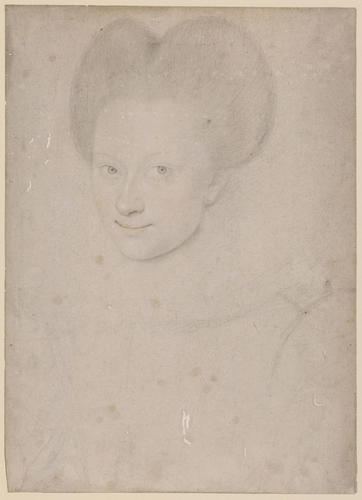-
1 of 253523 objects
A portrait of a woman c.1585-1595
Black and red chalk with wash | 32.2 x 23.4 cm (sheet of paper) | RCIN 913067

Attributed to François Quesnel (1543-1619)
A portrait of a woman c.1585-1595
-
A chalk portrait of a woman
The drawing is one of a set of eleven portraits of unidentified sitters (two male, nine female) at Windsor in the style established by Jean Clouet (c.1485-c.1541), and familiar from hundreds of surviving portraits by his French followers. Traditionally ascribed to a member of the Dumonstier family of artists, whose portrait drawings are much more solid in appearance, the Windsor series was instead attributed by Blunt to François Quesnel, by comparison with a large group of portrait drawings also attributed to that artist in the Bibliothèque Nationale in Paris. Quesnel was born in Edinburgh, son of the painter Pierre Quesnel (d.c.1594) who worked for James V and his French consort Marie de Lorraine. The Quesnels left Scotland while François was still a boy. He spent his working life in France, designing tapestries and coins, and specialising in portrait drawings of the aristocracy, distinguished by a lightness of touch and mood and with a superficiality of characterisation typical of French court portraits of the sixteenth century. On the basis of the costume, Anthony Blunt dated the portrait to the years 1585-95.
The drawings are rather worn in appearance, with faded pigments, yellowed paper and occasional worm-holes, and it is clear that they were framed and hung for a lengthy period of their history. They were first certainly recorded in the Royal Collection in the early nineteenth century, listed in Inventory A as II Black chalk Drawings of Portraits, [glazed struck through]. There are several references to albums in London during the seventeenth century that could conceivably have contained the eleven drawings now at Windsor. Charles I owned ‘one Booke with 49 Pictures by the life don in dry Cullors of the Cheifest Nobility and famous men at that tyme in ffraunce where at the end some 5 [further] drawings’; an annotation to one of the copies of that inventory states that the album was ‘Bought by the Kinge of the frenchman who brought the St John of Leonard de vincia’ - that is, the Duc de Liancourt. This may be identical with the ‘Boock of drawins’, to which inventory copies add ‘of great men and ladies’, listed at St James’s Palace during the Commonwealth. Also in England at the time was an album seen by Richard Symonds at Arundel House in 1653, ‘A booke of divers Ritrattos in miniature flat things all’. George Vertue’s transcription of Symonds’s notes, made the following century, adds ‘quere whether these were done by Holben. no (done in France)’. No such volume appears in the Kensington list of 1727, and it is not possible to assert that any of these references is relevant to the history of the Windsor drawings.
Text adapted from Holbein to Hockney: Drawings from the Royal CollectionProvenance
Royal Collection by c.1810
-
Creator(s)
-
Medium and techniques
Black and red chalk with wash
Measurements
32.2 x 23.4 cm (sheet of paper)
Category
Object type(s)
Other number(s)
RL 13067